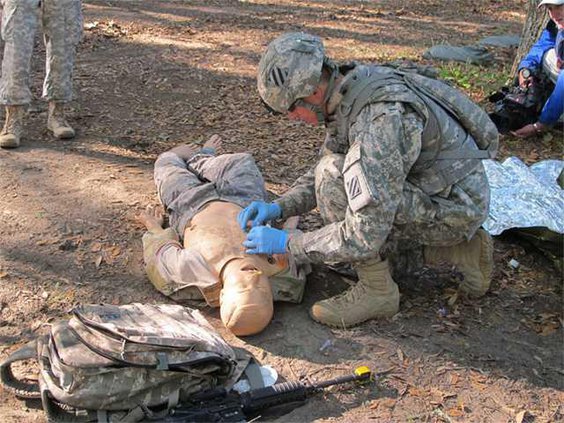Combat medics are the front line health-care providers for combat troops, and quite often, they are the difference whether a soldier survives a combat wound.
“The goal of (Expert Field Medical Badge) testing is to hone the combat medical training of our medics,” said Sgt. Maj. Johnathan Wright, division surgeon’s sergeant major, 3rd Infantry Division. “The most important thing to me is the training these candidates receive. I received my EFMB 1993, and I’ve seen a lot of changes since then. It’s very physically demanding. When other soldiers see that EFMB, they know you’re an expert in your field.”
According to the Fort Stewart public affairs office, the EFMB was established in 1965 as a Department of the Army special-skills award for field medical personnel.
Wright said a week of concentrated training was mandatory for all 3rd ID field medical personnel, but the week-long testing is voluntary. He said 17-21 percent of those who go into the testing actually earn their EFMB.
Most of those who do earn the badge have taken the test before, he said.
“I think the tactical training they get is very important,” he said, referring to soldier skills such as responding to enemy fire or to a nuclear, biological or chemical (NBC) hazard. “Important (medical) tasks include the litter carry, needle decompression (of a chest wound), and most of all, applying a tourniquet. With the level of (classroom and hands-on) training they’re receiving, I think it’ll save the lives of 90 percent of soldiers on the battlefield.”
Lt. Col. Richard Malish, a cardiologist, 3rd ID surgeon and officer in charge of this year’s EFMB testing program, said it has been more than eight years since EFMB testing has been conducted at Fort Stewart, mostly due to the unit’s deployments.
“We want our EFMB candidates to do well, but we have to maintain the highest skill standards for the testing process,” Malish said, explaining that a representative from the U.S. Army Medical Department Center and School at Fort Sam Houston, Texas, was there to oversee the program. “Of course, the ultimate goal of each candidate is to earn the EFMB, but the Army benefits from the training its medical personnel receive.”
Malish said the EFMB consists of 42 “title” tasks with hundreds of complex subtasks. He summarized the three lanes.
Lane 1 requires them to react to enemy fire by crawling to wounded soldiers and quickly assess the extent of their wounds, initially treat and stabilize them and move to cover. The medic does an assessment and treatment, such as applying a tourniquet, inserting a device to open a nasal passage and treating a chest wound — all under continued enemy fire.
Lane 2 consists of warriors’ skills. The candidate suddenly finds himself alone to carry out the mission.
Seeing evidence of an NBC hazard, the candidate must don a protective mask and gear then self-administer the antidote to a specific hazard.
This lane ends with the candidate supervising the loading of several wounded soldiers on the back of a Humvee.
Lane 3 requires the candidate to use radio equipment, negotiate a wire obstacle and treat a soldier with a spinal injury.
The final subtask requires him to move the injured soldier by litter to the rear, to include lifting the injured soldier over a walled obstacle.
Of the 176 candidates who began testing on Monday, 35 were dropped by the end of the first day.
Spc. Andrew Valerio, a health-care specialist with a scout platoon, survived the first day.
“So far, it’s been really good training,” Valerio said. “I got through the written test pretty well — thank the Lord. For me, the (nuclear, biological and chemical) lane will be challenging because that’s just not something we train a lot for at our unit. The patient assessment tasks in Lane 1 were the same ones I used in Iraq. For me, getting the EFMB would show that I’m one notch above my peers.”
Staff Sgt. Stuart Hollingsworth, a Lane 2 evaluator, expressed confidence that Valerio has the ability to earn the EFMB, having worked with him before and during the 3rd Battalion, 15th Infantry Regiment, 4th Infantry Brigade Combat Team’s last deployment to Iraq.
“He did a really good job for us over there,” Hollingsworth said. “He seems to be doing really good here so far.”
In addition to the hands-on tasks, EFMB candidates must complete a day-and-night land navigation course, 12-mile road march and a written exam.


